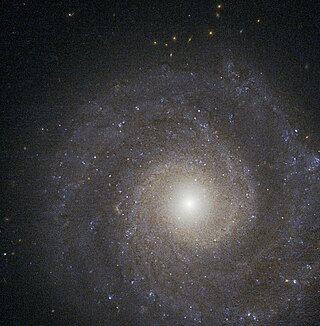Top Qs
Timeline
Chat
Perspective
IC 1993
Galaxy in the constellation Fornax From Wikipedia, the free encyclopedia
Remove ads
IC 1993 is an unbarred spiral galaxy in the constellation Fornax.[2] It was discovered by Lewis Swift on November 19, 1897. At a distance of about 50 million light-years, and redshift of 1057 km/s, it is one of the closest to us of the 200 galaxies in the Fornax Cluster.[2]
This article needs additional citations for verification. (September 2019) |
IC 1993 is a galaxy with several spiral arms in its disc, and it has a Hubble classification of (R')SA(s)bc, indicating it is an intermediate spiral galaxy with a ring on its outer edges. It is a remote galaxy, far from the center of the Fornax Cluster. It is at the edge of the Fornax Cluster. Near the galaxy is a bright foreground star that makes deep observations more difficult, so the galaxy's apparent magnitude is 12.6. Its size in the night sky is 2.5' x 2.2', and it has a diameter of 45000 light-years.
IC 1993 is one of the 25 galaxies known to have rings or partial rings. Most resemble local collisional ring galaxies in morphology, size, and clumpy star formation. Clump ages range from 108 to 109 yr, and clump masses go up to several × 108 solar masses, based on color evolution models. The clump ages are consistent with the expected lifetimes of ring structures if they are formed by collisions.
There are 15 other galaxies that resemble the arcs in partial ring galaxies but haven't evident disk emission. Their clumps have bluer colors at all redshifts compared to the clumps in the ring and partial ring sample, and their clump ages are younger than in rings and partial rings by a factor of ~10. In most respects, they resemble chain galaxies except for their curvature.
Several rings are symmetric with centered nuclei and no obvious companions. They could be outer Lindblad resonance rings, although some have no obvious bars or spirals to drive them. If these symmetric cases are resonance rings, then they could be the precursors of modern resonance rings, which are only ~30% larger on average. This similarity in radius suggests that the driving pattern speed has not slowed by more by ~30% during the last ~7 Gyr. Those without bars could be examples of dissolved bars.
Remove ads
See also
- NGC 1425, a similar spiral galaxy, also in the Fornax Cluster
- NGC 1532, another spiral galaxy in the Fornax Cluster
References
Wikiwand - on
Seamless Wikipedia browsing. On steroids.
Remove ads

